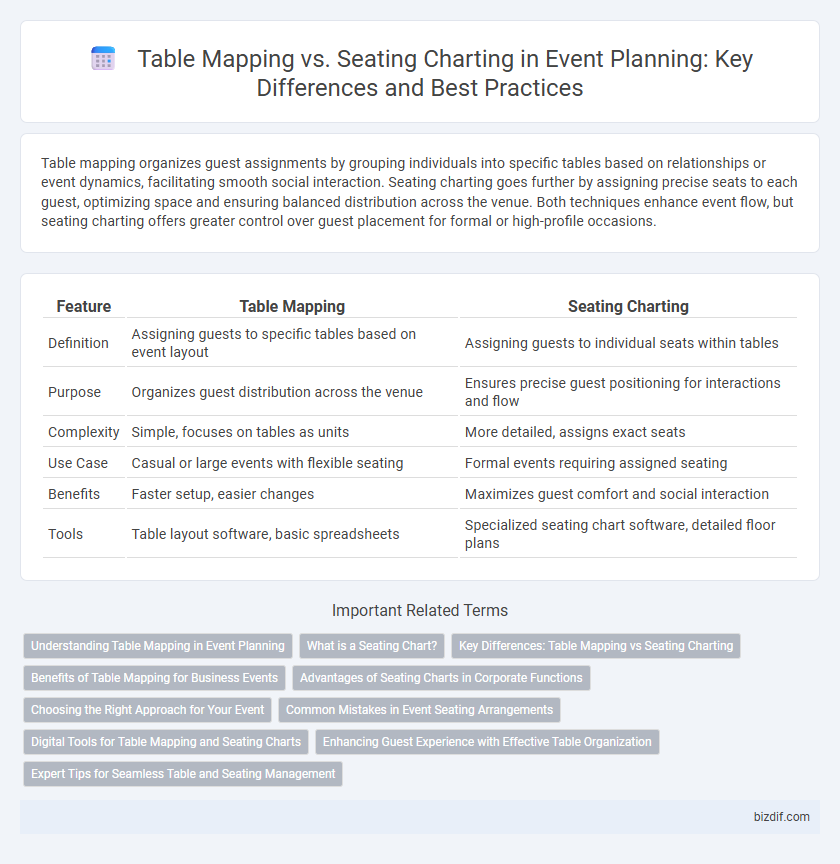Table mapping organizes guest assignments by grouping individuals into specific tables based on relationships or event dynamics, facilitating smooth social interaction. Seating charting goes further by assigning precise seats to each guest, optimizing space and ensuring balanced distribution across the venue. Both techniques enhance event flow, but seating charting offers greater control over guest placement for formal or high-profile occasions.
Table of Comparison
| Feature | Table Mapping | Seating Charting |
|---|---|---|
| Definition | Assigning guests to specific tables based on event layout | Assigning guests to individual seats within tables |
| Purpose | Organizes guest distribution across the venue | Ensures precise guest positioning for interactions and flow |
| Complexity | Simple, focuses on tables as units | More detailed, assigns exact seats |
| Use Case | Casual or large events with flexible seating | Formal events requiring assigned seating |
| Benefits | Faster setup, easier changes | Maximizes guest comfort and social interaction |
| Tools | Table layout software, basic spreadsheets | Specialized seating chart software, detailed floor plans |
Understanding Table Mapping in Event Planning
Table mapping in event planning involves assigning guests to specific tables based on factors like relationships, event layout, and capacity to optimize attendee experience. It streamlines spatial organization and ensures balanced distribution of guests, enhancing social interaction and comfort. Unlike detailed seating charts, table mapping focuses on broader table assignments, facilitating efficient logistics and flexible adjustments.
What is a Seating Chart?
A seating chart is a visual representation that assigns guests to specific seats at tables during an event, ensuring organized and efficient guest placement. It helps optimize space utilization, facilitates social interactions, and accommodates special needs or preferences. Unlike table mapping, which generally identifies table locations without specifying individual seats, seating charts provide precise seat assignments for each attendee.
Key Differences: Table Mapping vs Seating Charting
Table mapping organizes event spaces by assigning specific tables to guests or groups, ensuring efficient use of venue layouts and optimizing guest flow. Seating charting details the exact seat each guest occupies at a given table, enhancing personalized guest experience and facilitating meal service. Key differences include the broader spatial focus of table mapping versus the precise, individual-level arrangement in seating charting.
Benefits of Table Mapping for Business Events
Table mapping enhances business event efficiency by visually organizing guest distribution, improving networking opportunities and optimizing space utilization. Unlike seating charting, table mapping allows for flexible groupings that can adapt to changing attendee lists and event dynamics. This approach reduces logistical errors, simplifies event coordination, and elevates overall guest experience through strategic placement based on business priorities.
Advantages of Seating Charts in Corporate Functions
Seating charts enhance corporate functions by promoting structured networking and ensuring key stakeholders are strategically placed to facilitate important conversations. They reduce confusion and improve flow by clearly designating seats, which streamlines the event experience for both organizers and attendees. Precise seating arrangements also support brand image and professionalism, reflecting meticulous attention to detail that impresses clients and partners.
Choosing the Right Approach for Your Event
Table mapping organizes guests by connecting individuals to specific tables, streamlining group dynamics and enhancing social interaction. Seating charting assigns exact seats to attendees, optimizing layout for formal events and ensuring order. Selecting the right approach depends on the event's formality, guest preferences, and spatial logistics to balance comfort and flow.
Common Mistakes in Event Seating Arrangements
Common mistakes in event seating arrangements include confusing table mapping with seating charting, leading to disorganized guest placement and poor flow during the event. Table mapping focuses on the layout and number of tables, while seating charting precisely assigns guests to specific seats, preventing conflicts and ensuring smooth social interactions. Overlooking guest preferences or special requirements often results in discomfort and dissatisfaction, highlighting the importance of detailed seating charting alongside accurate table mapping.
Digital Tools for Table Mapping and Seating Charts
Digital tools for table mapping streamline the arrangement of event layouts by offering drag-and-drop interfaces and customizable templates for different table shapes and sizes. Seating chart software enhances guest management by enabling planners to assign seats based on preferences, dietary restrictions, and social dynamics, often integrating with RSVP and guest list platforms for real-time updates. Advanced solutions like AllSeated and Social Tables provide 3D visualization and collaborative features, improving accuracy and efficiency in event seating and overall space optimization.
Enhancing Guest Experience with Effective Table Organization
Effective table mapping ensures guests are grouped by common interests or relationships, fostering natural interactions and comfort. Seating charting complements this by assigning specific seats, minimizing confusion and streamlining arrival processes. Together, these strategies enhance guest experience by creating an organized, welcoming environment that promotes social engagement and event flow.
Expert Tips for Seamless Table and Seating Management
Effective table mapping involves organizing tables based on the venue layout and guest categories to optimize space and flow, while seating charting assigns specific guests to seats to enhance social dynamics. Expert tips include using digital tools for real-time updates and grouping attendees by interests or relationships to promote interaction. Prioritizing flexibility and clear communication with venue staff ensures seamless coordination and guest satisfaction during the event.
Table mapping vs Seating charting Infographic

 bizdif.com
bizdif.com